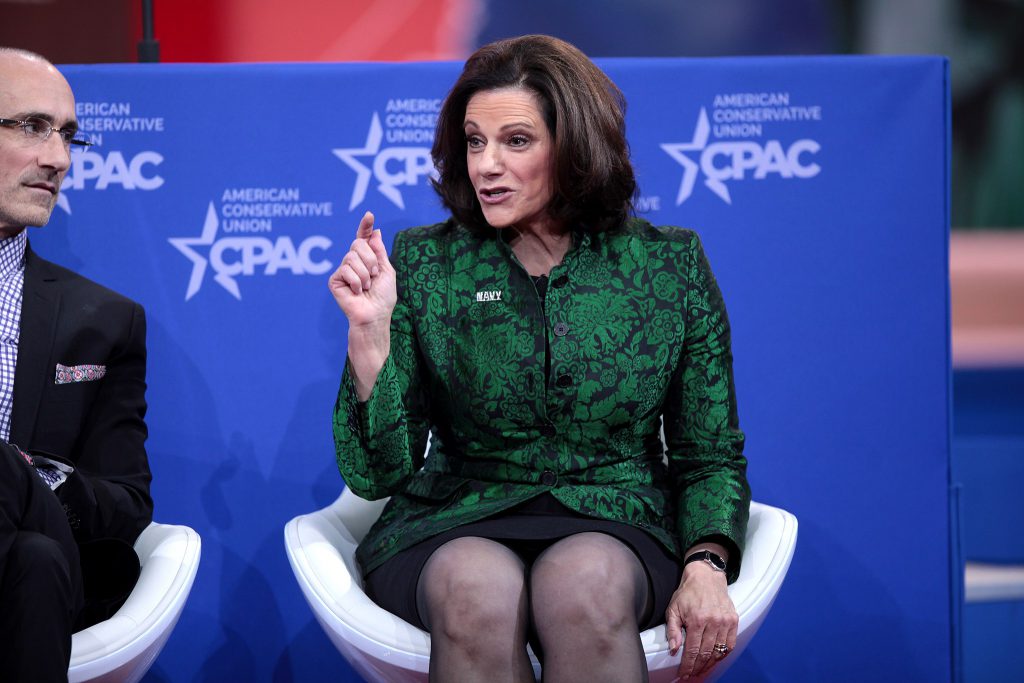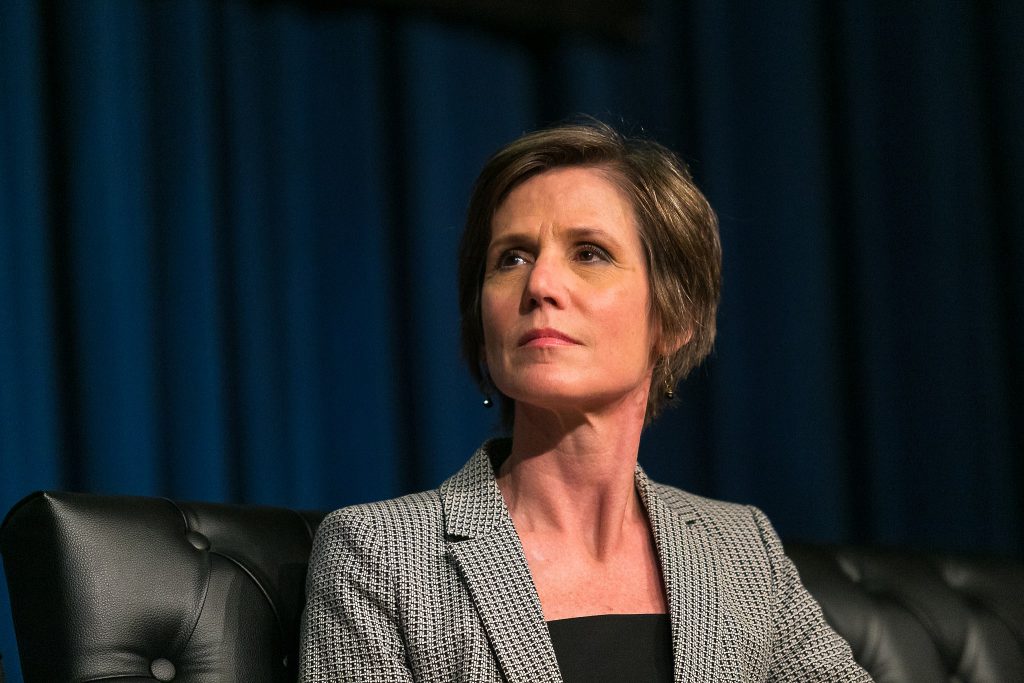WASHINGTON — Tuesday’s announcement that Secretary of State Rex Tillerson would be replaced by CIA director Mike Pompeo marks the latest high-profile exit in an administration characterized by upheaval.
Tillerson joins economic adviser Gary Cohn and communications director Hope Hicks as three major departures in the last two weeks alone, raising questions about the long-term stability of the uppermost staff in the White House. But many federal employees lasted an even shorter amount of time than Tillerson, Cohn and Hicks. In fact, warning signs of high turnover were clear from the president’s first week in office.
The ten shortest tenures for top federal employees, most of whom left within the first few months of the administration, paint a picture of a president at odds with even his highest-ranking advisers.
10. Sean Spicer, White House Press Secretary, 183 days (1/20/17 – 7/21/17)

Sean Spicer addresses the White House Press Corps during his brief, tumultuous time as Press Secretary. Photo Credit: By Jake Turx (Own work) [CC BY-SA 4.0 (https://creativecommons.org/licenses/by-sa/4.0)], via Wikimedia Commons
Spicer became one of the biggest public figures within the administration almost immediately after sparring with members of the media about inaugural crowd sizes. Spicer’s fiery performances at the podium spawned a Saturday Night Live skit in which the secretary was portrayed by actress Melissa McCarthy.
He was also widely criticized for a number of false comments he made during his tenure, including an assertion that Adolf Hitler didn’t use chemical weapons, that the Supreme Court unanimously ruled against Barack Obama’s executive orders, and — most famously — the size of the crowd at the inauguration.
After months of public turmoil, Spicer finally resigned last July as a protest against the president’s decision to hire Anthony Scaramucci as WHCD. Spicer was replaced by Sarah Huckabee Sanders, who has held the position since.
9. George Sifakis, Director of the Office of Public Liaison, 164 days (3/8/17 – 8/18/17)

George Sifakis’s official headshot. Photo credit: White House, via Wikimedia Commons.
George Sifakis previously served as a White House aide to George W. Bush and was known as a close friend of Reince Priebus, the Chief of Staff whose White House departure preceded Sifakis’s.
News of Sifakis’s departure received less attention than same-day reports that Steve Bannon was departing his own position as chief strategist. Bannon, unlike Sifakis, had worked at the White House since the inauguration.
8. K.T. McFarland, Deputy National Security Adviser, 120 days, (1/20/17, 5/19/17)

Former Deputy NSA KT McFarland at a conservative event in 2015. Photo credit: By Gage Skidmore from Peoria, AZ, United States of America (KT McFarland) [CC BY-SA 2.0 (https://creativecommons.org/licenses/by-sa/2.0)], via Wikimedia Commons
In the Trump administration, McFarland was known for her closeness with then-National Security Adviser Michael Flynn. Flynn was famously indicted by Special Counsel Robert Mueller in December for making false statements to the FBI; McFarland has reportedly spoken with investigators as part of the Russia probe.
McFarland left her post at NSA after Trump nominated her for the ambassadorship to Singapore. However, she withdrew from consideration when the nomination stalled in the Senate over concerns about the investigation into Russian meddling in the 2016 election.
7. James Comey, FBI Director, 110 days (1/20-17 – 5/9/17)

Former FBI Director James Comey addresses an Alabama church in 2016. Photo credit: Federal Bureau of Investigation via Wikimedia Commons.
Of all the short tenures on this list, Comey’s may be the most consequential.
Comey served as FBI Director for more than three years, but he only lasted for a few months of Trump’s tenure. When the president famously fired Comey last May, the former FBI director reportedly found out about his own termination by seeing it on a televised newscast.
The White House originally stated that Comey was fired due to his handling of the investigation into Hillary Clinton’s use of a private email server while Secretary of State. Later, Trump tells NBC reporter Lester Holt that Comey was fired because, “I said to myself, I said, ‘You know, this Russia thing with Trump and Russia is a made-up story, it’s an excuse by the Democrats for having lost an election that they should have won.’”
After reports surface that Trump had urged Comey to end an investigation into Michael Flynn, Special Counsel Robert Mueller is appointed to investigate Russian interference in the 2016 presidential election.
6. Mike Dubke, White House Communications Director, 89 days (3/6/17 – 6/2/17)

CBS’s official Twitter account reports Dubke’s departure, May 2017. https://twitter.com/CBSNews/status/869519865660551168
The second person to serve as WHCD after Spicer left the role, Dubke lasted just under three months before calling it quits. His tenure as WHCD was plagued by a series of apparently irrepressible leaks from top White House officials to major media outlets.
At the time, Dubke said he was leaving for “personal reasons;” he later told reporters that he also didn’t want to have to sell off his businesses in compliance with Office of Government Ethics requirements.
Still, he says, he does have some sense of regret about leaving so soon. “When you walk away from a situation in which you are really in the trenches with your colleagues, and you step away from that … I did have some remorse after I left,” he told the Washingtonian. “Because I felt like I left them behind.”
5. Katie Walsh, Deputy Chief of Staff, 70 days (1/20/17 – 3/30/17)

Walsh addresses a summit in 2017. Photo credit: By Web Summit (CG1_8354) [CC BY 2.0 (http://creativecommons.org/licenses/by/2.0)], via Wikimedia Commons
Walsh was reportedly close with Reince Priebus, under whom she worked He left the White House a few months after she did.
Walsh returned to headlines briefly at the beginning of 2018, when Michael Wolff’s tell-all book Fire and Fury: Inside the Trump White House alleged that she compared working with Trump to “trying to figure out what a child wants.” She has denied making the comments in question.
4. Preet Bharara, United States Attorney, 51 days (1/20/17 – 3/11/17)

Bharara’s official headshot. Photo credit: Dept. of Justice via Wikimedia Commons.
Trump had originally asked Preet Bharara to stay on as US Attorney for the Southern District of New York, a position for which he was originally nominated by Obama in 2009.
However, fewer than two months into Trump’s first year as president, Bharara was asked to resign. He told ABC’s George Stephanopoulos that the request for his resignation came after a series of phone calls in which the then-president-elect appeared to be “trying to cultivate some kind of relationship.”
Bharara refused to resign, and was subsequently fired. Bharara now runs a very popular podcast, Stay Tuned with Preet, in which he analyzes major legal issues, including the Mueller investigation, and answers listener questions.
3. Michael Flynn, National Security Adviser, 25 days (1/20/17 – 2/13/17)

Flynn at a Trump rally in 2016. Photo credit: By Gage Skidmore from Peoria, AZ, United States of America (Michael Flynn) [CC BY-SA 2.0 (https://creativecommons.org/licenses/by-sa/2.0)], via Wikimedia Commons
The president has been publicly supportive of Flynn, describing the former national security adviser as “a wonderful man” in comments to reporters just two days after the firing. “I think he’s been treated very, very unfairly by the media… in many cases,” Trump said.
On Dec. 1, 2017, Flynn pleaded guilty to making false statements to the FBI. He is cooperating with Special Counsel Mueller’s investigation into Russia’s role in the 2016 presidential election.
2. Sally Yates, Acting Attorney General, 11 days (1/20/17 – 1/30/17)

Yates at a speaking engagement in 2016. Photo credit: Dept. of Labor via Wikimedia Commons.
Like Bharara, Yates had been nominated by Barack Obama, but was made acting Attorney General when Trump was inaugurated.
One of President Trump’s first actions in office was to impose a ban restricting travel from several Muslim-majority countries. As acting AG, Yates refused to defend this ban in court and was subsequently fired. During Yates’s brief tenure, then-NSA Michael Flynn was under suspicion for being possibly subject to Russian blackmail.
“It was such a blur,” Yates said of her 11 days in office in an interview with Financial Times. “We didn’t even eat lunch during this time because we were dealing with all the Mike Flynn stuff.”
1. Anthony Scaramucci, White House Communications Director, 10 days (7/21/17 – 7/31/17)

Scaramucci speaking at a conference in 2016. Photo credit: By Jdarsie11 (Own work) [CC BY-SA 4.0 (https://creativecommons.org/licenses/by-sa/4.0)], via Wikimedia Commons
Scaramucci was brought on to shake up the White House’s communications team after a series of high-profile missteps by Spicer, but “the Mooch” soon became known for his own faux pas.
On July 26, 2017, Scaramucci called New Yorker reporter Ryan Lizza and unleashed a vulgar tirade about leaks from the White House, calling then-Chief of Staff Reince Priebus a “f—ing paranoid schizophrenic, a paranoiac,” and complaining that he had been “c—-blocked” by Priebus. The Chief of Staff was replaced two days later — but Scaramucci was soon fired, too.
“The morale’s very low,” Scaramucci told NPR about the White House this week. “There is a martial control situation that doesn’t really work well in a civilian environment. And the – I expect there will be more exoduses from the White House now unless that system changes.”

